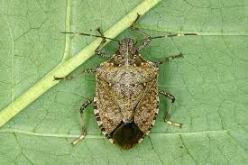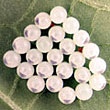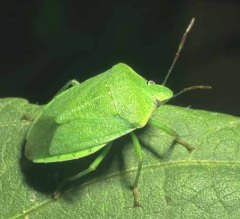It doesn’t matter where you live or what color the stink bugs are, all stink bugs that comprise the nearly 200 different species have two things in common: they feed on everything and they stink! These invasive, stinky critters seem to multiply exponentially overnight and are a very troublesome pest.
Description:
The stink bug is part of the family of insects called pentatomids meaning “5-sided”. Common varieties include the brown marmorated stink bug (BMSB), southern green stink bug, two spotted stink bug, arboreal stink bug, red shouldered stink bug, rice stink bug, consperse stink bug and several others.
Adult stink bugs are distinctly shield shaped and vary in color depending on species. Most stink bugs are variations of brown or green and different species may have yellow, red or pink markings. Adults are approximately slightly over ½ inch long.
There is usually a single generation per year but a warm spring and good summers can see up to 3 generations. Adults overwinter on the ground under leaves, in dense foliage or on certain weeds (Russian thistle, little mallow) and emerge in spring to mate and lay drum shaped eggs in clusters on foliage of host plants, on stems and the underside of leaves.
When eggs hatch, nymphs grow through 5 developmental stages over the course of 4-5 weeks before maturing into adults.
Host Plants:
Stink bugs are known to feed on tomatoes, peppers, corn, soybeans, wheat, clover, sorghum, peas, beans and okra among other food crops. They also go rampant on fruit like apples, peaches, figs, mulberries, citrus fruits, persimmons, grapes, raspberries and more.
Damage:
Stink bugs feed by puncturing plant tissue and sucking sap with their sharp piercing-sucking mouthparts. They also pierce the peel or hull of fruiting structures and feed on the inner contents. They prefer feeding on developing seed and will preferentially do so.
Seeds that are damaged when small fail to develop. Larger seeds will have sunken white or discolored areas where feeding has taken place. The damage on peas, butter beans and green beans is like this.
On tomatoes and peppers damage usually appears as irregular shaped white or yellow blotches under the skin. Fissures below the surface harden. Sting points may also produce dark pinprick marks on fruit.
Both adults and nymphs have same feeding habits and do similar damage. Killing a stink bug does not attract other stink bugs.
Organic Control and Prevention of Stink Bugs:
1. Cultural control: Destroy heavily weeded and bushy areas in and near your garden. Adult stink bugs prefer overwintering in such sites among legumes, blackberries, Russian thistle, mustards and little mallow. Till the growing area, destroy and rid of crop debris and good weed management will help minimize stink bug populations.
2. Monitor and handpick: Stink bugs are somewhat sluggish and can be caught easily. They do release a stink gas when threatened so beware and cover your nose! Remove them and drop them into a bucket of soapy water. Shaking infested plant or tree will send them tumbling down. Vacuuming them off is also an option. Spray plants with water to knock them down and kill them off.
3. Plant trap crops: Mustard, millet, buckwheat, sorghum, sunflower, marigolds, lavender and chrysanthemums are good trap crops to attract stink bugs to attack them rather than your crop of interest. Once these trap crops are infested, the stink bugs can be killed with ease.
4. Physical traps: Yellow sticky traps or bucket painted yellow filled with soapy water can rid of quite a few unsuspecting stink bugs. An open pipe painted yellow stuck into the ground can also be used effectively for trapping stink bugs. Then there are commercially available stink bug traps that can be tried out.
5. Beneficial insects include ants, ladybird beetles and some lacewings, all of which destroy stink bug egg masses. Attract these insects by planting several nectar producing flowers.
6. Sprinkle diatomaceous earth in your garden and in prone areas. It works by breaking down the waxy protective layer on the stink bugs exoskeleton, eventually causing it to dehydrate.
7. Make a garlic spray and use as frequently as needed. Stink bugs detest the potent smell of garlic and will repel them from your garden.
8. Kaolin, a soft, white silicate clay mineral can be combined with water to form a protective physical powdery barrier that will prevent stink bugs and other pests from feeding on plant tissue.
9. Use an organic insecticidal soap and spray this solution directly on stink bugs or in areas they frequent. The soap kills the bugs by breaking down their protective exterior and dehydrating them.
10. Neem oil is another natural product that can help reduce stink bug populations by disrupting their feeding and mating habits.
11. Companion planting: Plant garlic, tansy, mint, catnip and radish to help repel stink bugs.




Leave a comment
Comments feed for this article